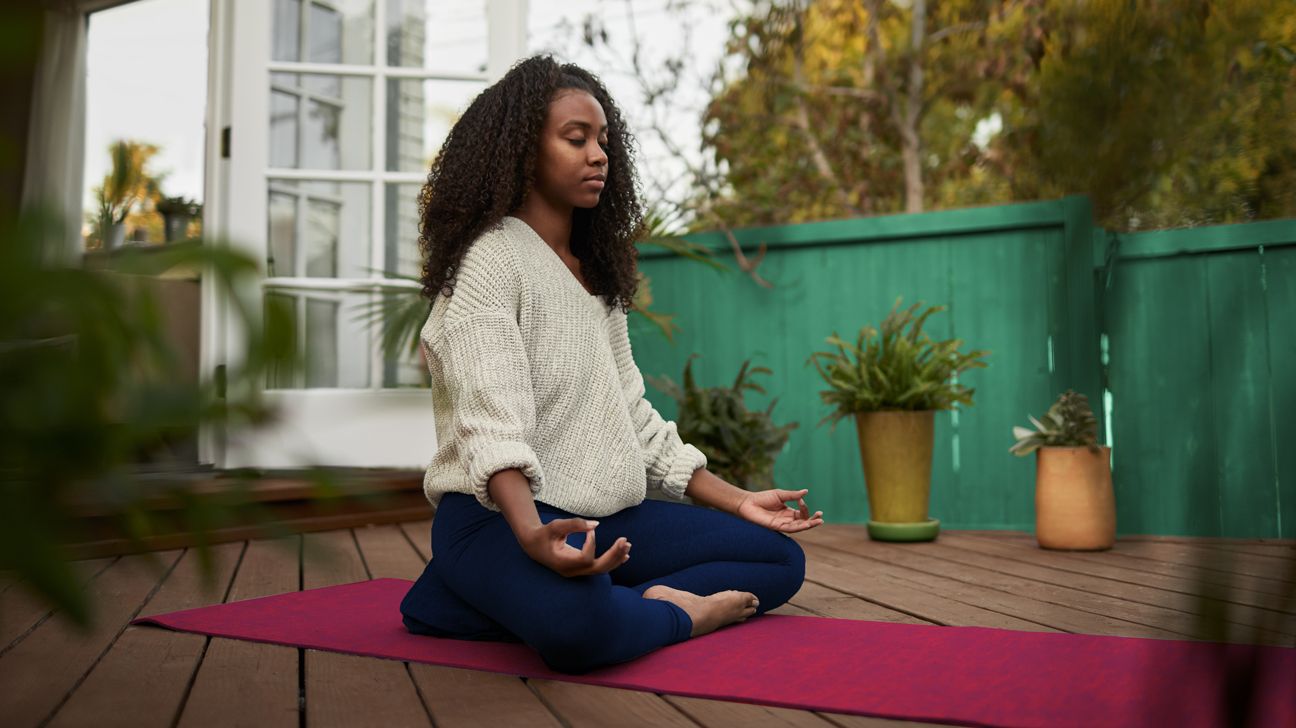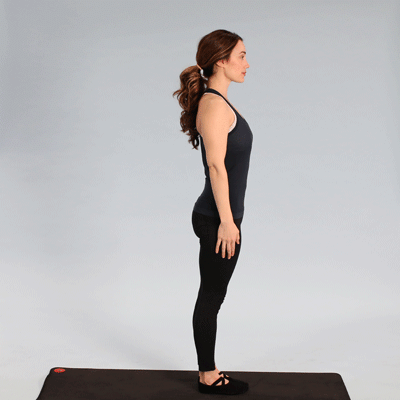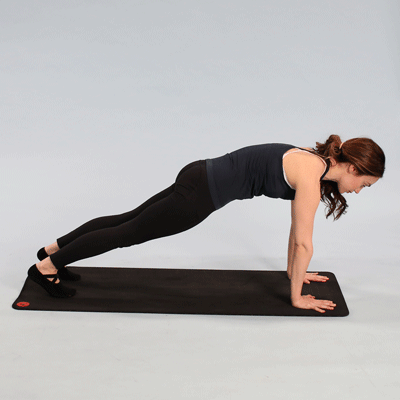Though it may seem like yoga was invented for Instagram influencers to pose meaningfully on mountaintops, the ancient practice has been around for thousands of years and boasts a range of health benefits.
Some studies show that yoga decreases anxiety and increases cognitive performance, helps stretch the body, helps reduce pain, and lessens symptoms of depression.
Despite all the good things yoga does, it’s still hard to know where to start. I know I’ve heard “You don’t have to be flexible to do yoga” a million times, but when you can’t put your heels down in Down Dog and your head feels a million miles from your toes in a forward fold, it’s not encouraging.
Fortunately, you really can do yoga at any age, flexibility, and fitness level. With these basic yoga moves, you’ll learn the foundations of the practice without spraining a groin muscle.
Bonus: You can do all of these yoga poses at home. So, get out your stretchy pants and some meditative music and try these excellent yoga poses for beginners.
Tadasana
This might look like just standing there position, but it’s actually the foundation of all yoga standing poses. Mountain Pose gives you awareness of your body and improves posture.
Stand with your feet only slightly apart and big toes touching. Feel the weight of your body balanced evenly between the balls and heels of your feet. Keep your knees slightly bent and lift your upper body, as though it’s being gently pulled by a string from the top of your head.
As you maintain this pose, breathe deeply, feeling your stomach (just below the diaphragm) move with each inhale.
Note: For all poses in this list, maintain deep relaxed breathing. This seems obvious (“I have to breathe while I do yoga, who knew?!”), but you’d be amazed how often you hold your breath or breathe shallowly during yoga practice. tl;dr: Keep breathing. Deeply.
Utkatasana
Sadly, Chair Pose does not involve a chair or actual sitting of any kind. Happily, chair pose is a great exercise for your legs and core, plus it gently elevates heart rate and increases circulation.
If you feel any pressure or pain in your knees for this position, decrease the bend. You don’t have to squat all the way down to feel the benefits, so keep the movement safe for your body.
Start in Mountain Pose and raise your hands straight up. Maintain that “my head is being lifted to the ceiling” feeling as you bend your knees.
With hips moving backward, bend your knees as if you were sitting in an imaginary chair. If you can, try to get your thighs parallel to the floor.
All the while, keep your arms straight overhead and remain in the pose for 30 to 60 seconds. If you can only do 10 seconds and your knees are just barely bent, that’s fine, too.
Uttana shishosana
If flexibility is not one of your strengths (we get you), Downward Dog might often seem a pose of disappointment. You’re not the only one who’s Down Dog may look more like Sad Dog That Just Wants to Lay Down. If you’d like to gain flexibility and ease into the pose, try this modification. All you need is a chair.
Put your hands on the back of a chair with your arms shoulder-width apart. Move your feet back until they’re right under your hips. Your body should be at a 90-degree angle. Stay in this right-angle pose and gently pull the hips and hands away from each other. Hold the pose for 30 to 60 seconds.
If you’d like to advance to Downward Facing Dog, place your hands on the floor and walk your feet back until your body makes that same right angle. Lengthen your legs and send your feet toward the floor.
Virabhadrasana I
To increase strength in the legs and continue to improve posture, try Warrior I. As you go into the pose, focus on keeping shoulders relaxed and the ribcage lifted.
Start in Mountain Pose, then step the left leg back about 3 feet. With feet parallel (facing the front), bend your right leg. In this mini-lunge, make sure your knee stays in line with your front foot and never moves out past the toes.
Lastly, reach your arms straight up to the ceiling, relaxing the shoulders away from your ears. Hold the pose for 30 to 60 seconds, or more if it feels comfortable. Repeat on the opposite side.
Virabhadrasana II
If you liked Warrior I, you’ll love the sequel: Warrior II — The Legend of Curly’s Gold. A variation on the power pose, Warrior II increases stamina and lightly opens the hips. Trying holding Warrior I then going right into Warrior II for a mini-flow.
Same as Warrior I, stand with your feet about 3 feet apart. Rotate your back foot 90 degrees. Now, the front foot is pointing front, the back foot is pointing to the side, and the hips are open to the side.
Bend your front knee (remember not to extend the knee beyond the toes) and raise arms out (like a T) as though you’re trying to reach the walls with your fingertips. Keep your torso centered between both legs. Hold the pose for 30 to 60 seconds. Repeat on the opposite side.
Vrksasana
Yes, this looks hard. But you don’t need to get your heel all the way to your genitals for this to be an effective pose. Tree Pose is ideal for strength and balance. The key is to start small.
Start in Mountain Pose. Raise your right leg. To start, place your right foot by your left ankle. Turn your right leg out to the side, rotating from the hip. Keep a sense of grounding in your left leg, keep that lifted posture, and try to balance. If your balance is great, try to lift your right leg higher.
If your balance is not ideal, place your right toe on the floor. That still places more weight on the left and helps increase balance (without worrying about falling on your face). Hold for at least 30 seconds. Repeat on the opposite side.
Ardha Uttanasana
A great pose for hamstring flexibility, the Standing Half Forward Bend is a good option for those that can’t touch their toes. Even if you can touch your toes, this lengthening posture is a good warm-up for poses that require more flexibility.
Starting from Mountain Pose, bend halfway down, keeping your back straight. Rest your hands on your thighs, shins, or the floor (depending on flexibility). Push against your thighs (or shins or floor) to lengthen your back further.
Take a few deep breaths in this extended position. Then, relax your arms and back, and slowly roll back up to Mountain.
Anjaneyasana
For anyone who sits most of the day, this is a great pose to stretch all those tight muscles. Opening up the hips, quads, and hamstrings, this floor pose should feel really good.
Start on the floor. Sitting up on your knees, place your right leg forward. Place your hands on either side of the right foot. Slide the left leg back until you feel a comfortable stretch.
For those with more limited flexibility, it may be helpful to use yoga blocks underneath your hands. Make sure your right knee doesn’t bend over the toes. Hold the pose for at least 30 seconds. Repeat on the opposite side.
Setubandha
Bridge Pose increases flexibility of the spine and helps strengthen the core. This pose brings blood flow to the heart and though it can feel awkward at first, it just takes a little practice to feel the effects of this invigorating posture.
Lie down on your back. With your knees bent and feet hip-width apart on the floor, lift your hips. You’ll feel your quads, hamstrings, and glutes engage as you draw your hips toward the ceiling. Hold for 30 to 60 seconds, then slowly and gently bring your hips back to the floor.
Baddha Konasana
A simple pose to open the hips and counteract a day of sitting and staring at the computer. As you ease into this pose, be sure to not force any movements. Go to where you feel a stretch without feeling any discomfort or pain.
If you have tight hips or hamstrings, sit on a low pillow or blanket to elevate the hips. Next, bend your legs with your feet together and gently move your feet toward your hips. Hold the big toe of each foot and lightly pull outward.
Let the knees relax toward the floor and keep your ribcage, spine, and neck lifted. Don’t force the knees to the floor. If they don’t touch now — that’s fine! Think of letting the muscles in your legs relax and over time, your flexibility will increase.
Paschimottanasana
An excellent stretch for the back and hamstrings, this pose also offers a great chance to recenter on your breath and calm your thoughts. If you aren’t super flexible, get a scarf, towel, or strap to help you make the most of this bend.
Sit on the floor with your legs out straight. Keeping your posture lifted, bend at your hips and reach toward your toes. If you can’t reach your toes, use a towel (or strap). Don’t collapse your body onto your legs.
Keep your ribcage lifted and shoulders down as you reach toward your toes and feel the stretch in your legs.
Simhasana
Though these poses are simple, they aren’t necessarily easy. It is easy to let tension creep into your jaw and tongue though, as you focus on releasing all the other body parts. To make things a little silly and open up the smaller muscles, try Lion Pose.
Sit cross-legged on the floor with your ribcage lifted. Take a deep inhale through your nose. On the exhale, stretch your mouth open wide and stick out your tongue. Let out a “haaa” sound as you exhale. Repeat as many times as you like. It’s surprisingly cathartic.
Marjaryasana
A wonderful stretch, the Cat (and following Cow pose) are like little massages for the spine. Maintain that deep relaxed breath to increase your stretch.
On the floor, rest on your hands and knees in a tabletop position. Exhale and curve your back toward the ceiling. Move slowly and release your head toward the floor as your back curves upward. Inhale and bring your spine back to neutral position.
Don’t force anything. Just gently move the spine up to increase flexibility and release tension. Repeat the movement at least three times or as many as feels good to you.
Bitilasana
Cow Pose lightly stretches the stomach while increasing flexibility of the spine. Pair this with Cat Pose for a lovely, easy flow.
On the floor, rest on your hands and knees in a tabletop position. On an inhale, lift your sitting bones toward the ceiling and chest forward, letting your belly drop toward the floor. On the exhale, return to neutral position (or go into Cat Pose for increased range of movement).
Viparita Karani
As a very beginner at yoga, the idea of headstands might be pretty frightening. But you can get some of the same effects of inverted postures with Legs Up The Wall Pose.
This increases circulation to your chest and gently stretches the legs and lower back. It’s extremely calming and you can do it wherever you have a wall.
Place folded blankets under your pelvis for support about 5 to 6 inches away from the wall. Lay on your back on the support, then move your legs up the wall. Your legs should be straight (if possible) and vertical.
If the stretch is too strong, scoot a few more inches from the wall. If it’s too light, move closer to the wall. Feel your hips and shoulders sink into the floor as your legs relax against the wall.
Stay in the pose for at least 1 minute, though you can go up to 15 minutes if it’s comfortable for you.
Balasana
You can use this pose at the end of your practice or whenever you need a break. Child’s Pose gently stretches along the back and gives you a chance to refocus on your breath and relax.
Kneel on the floor with your big toes touching. Move the knees about hip-width apart. Sit back on your heels and lay your upper body between your thighs. Imagine lengthening your spine and releasing your shoulders as you relax into the pose.
Keep the pose for at least 30 seconds, though you could stay in it for 30 minutes if you felt like it. This is an excellent opportunity to breathe and congratulate yourself for trying something new.
Knowing these yoga basics will make it much easier for you to join a class, whether in person or at home. With these bonus tips, you can walk into class with high level confidence.
Try hatha yoga
Hatha yoga gets a bad rap for being “slow” yoga, but it’s focus is more deliberate. Rather than trying to get your heart up in a high-intensity flow, Hatha Yoga gives you a bit more time to explore each pose before moving on.
If you can’t find a Hatha class, don’t worry. Vinyasa yoga varies in intensity from class to class, teacher to teacher. See if you can take a free trial class before making a major commitment, a good tip for any type of yoga.
Maybe don’t do hot yoga
As an absolute beginner, hot yoga or Bikram yoga may be a bit much. The 90°F (32°C) (or more!) heat makes standing still hard, let alone going through the poses. You may also experience dizziness and increased heart rate doing hot yoga (not great). Start at room temperature, then work your way up.
Don’t be afraid to show off your body
You don’t need to go shirtless with hot pants, but don’t be afraid to wear form-fitting clothes that allow you to move.
The teacher is there to guide you through the poses and kindly correct your positioning. When you wear baggy clothes, it makes it hard for the teacher to see your posture and make corrections (plus, you don’t want your shirt flopping up to your shoulders in Down Dog).
So, show yourself off! Or wear a reasonably form-fitting shirt, whatever you’re comfortable with.
Bring water
Just because this isn’t boot camp, doesn’t mean you won’t sweat. Yoga can be intense, so bring water to stay hydrated and healthy through the class.
Don’t stay in a bad class
There are many lovely yoga teachers and some that are… not. If you don’t vibe with the teacher, try another class. Look for an instructor that actively participates and interacts with students.
You may not be able to get into all the poses yourself as you start out. The teacher should be there to help you find alternative poses or give you a tiny nudge to get you in the right position.
If your instructor doesn’t support you when you need them (or is one of those too attentive types that thrives on singling newbies out), roll up your mat and namaste right on out the door.
You might fart (the world won’t end)
Farting in yoga is an old joke, but there’s truth in comedy. You might fart. And you know what, it’s okay. In yoga, you’re meant to focus on all aspects of your body throughout the practice.
That means people are spending their time focusing on themselves, not on judging others. That non-judgment includes gas. So, if you do fart, say excuse me and go back to work. Or laugh about it!
You might feel silly in the moment, but really, we’ve all been there. A yoga fart will not make you a social pariah.
It’s OK if it’s not for you
Yoga is an excellent form of exercise, but it’s not for everyone. It’s great to give it a try, since the physical and mental benefits are so bountiful. But yoga is not everyone’s cup of tea. If you try a class and some at-home workouts and you still can’t get into it, let it go.
You can always come back to yoga later.




